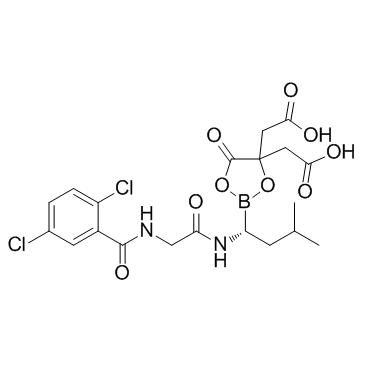1239908-20-3
| Name | 2-[4-(carboxymethyl)-2-[(1R)-1-[[2-[(2,5-dichlorobenzoyl)amino]acetyl]amino]-3-methylbutyl]-5-oxo-1,3,2-dioxaborolan-4-yl]acetic acid |
|---|---|
| Synonyms |
1,3,2-Dioxaborolane-4,4-diacetic acid,2-[(1R)-1-[[2-[(2,5-dichlorobenzoyl)amino]acetyl]amino]-3-methylbutyl]-5-oxo-
1,3,2-Dioxaborolane-4,4-diacetic acid,2-((1R)-1-((2-((2,5-dichlorobenzoyl)amino)acetyl)amino)-3-methylbutyl)-5-oxo 2-[4-(carboxymethyl)-2-[(1R)-1-[[2-[(2,5-dichlorobenzoyl)amino]acetyl]amino]-3-methyl-butyl]-5-oxo-1,3,2-dioxaborolan-4-yl]acetic acid Ixazomib citrate (USAN) MLN9708 2-[(1R)-1-[[2-[(2,5-dichlorobenzoyl)amino]acetyl]amino]-3-methylbutyl]-5-oxo-1,3,2-dioxaborolane-4,4-diacetic acid UNII-46CWK97Z3K 2,2'-{2-[(1R)-1-{[N-(2,5-Dichlorobenzoyl)glycyl]amino}-3-methylbutyl]-5-oxo-1,3,2-dioxaborolane-4,4-diyl}diacetic acid Ninlaro 1,3,2-Dioxaborolane-4,4-diacetic acid, 2-[(1R)-1-[[2-[(2,5-dichlorobenzoyl)amino]acetyl]amino]-3-methylbutyl]-5-oxo- |
| Description | Ixazomib citrate (MLN9708) is a reversible inhibitor of the chymotrypsin-like proteolytic β5 site of the 20S proteasome with an IC50 of 3.4 nM and a Ki of 0.93 nM. |
|---|---|
| Related Catalog | |
| Target |
IC50: 3.4 nM (20S proteasome β5), 31 nM (20S proteasome β1), 3500 nM (20S proteasome β2)[3] |
| In Vitro | Ixazomib citrate (MLN9708; 0.20-3.20 µM) inhibits the cell growth of both cell lines effectively in a time- and dose-dependent manner. Ixazomib induces cell cycle arrest in MG-63 and Saos-2 cells. Ixazomib induces apoptosis mainly through the caspases pathway and requires the activation of both caspase8 and caspase9. Ixazomib treatment increases the levels of pro-apoptotic proteins and down regulates the anti-apoptotic proteins that control MOMP. Ixazomib treatment induces the release of Cytc, Smac, OMI from mitochondria and decreases the protein levels of XIAP. Ixazomib inhibits the invasion ability of MG-63 and Saos-2 cells and decreases both the expression and secretion levels of MMP2/9[1].Ixazomib citrate (MLN9708; 12 nM) shows inhibitory activity against C-L and T-L proteasome activities. Treatment of H929 and MM.1S MM cells with Ixazomib triggers a marked increase in proteolytic cleavage of poly(ADP) ribose polymerase (PARP), a signature event during apoptosis. Ixazomib induces cleavage of caspase-3, an upstream activator of PARP. Ixazomib induces eIf2-α kinase activity and protein levels of Bip and CHOP/GADD153. Ixazomib blocks BMSCs-induced MM cell proliferation, inhibits in vitro capillary tubule formation, and target NF-κB[2]. |
| In Vivo | Ixazomib citrate (MLN9708; 11 mg/kg) significantly inhibits MM tumor growth and prolongs survival in the human plasmacytoma MM.1S xenograft mouse model. The blood chemistry profiles of Ixazomib-treated mice show normal levels of creatinine, hemoglobin, and bilirubin. Ixazomib dramatically increases the number of cleaved-caspase-3 positive cells of the xenograft model[2]. |
| Cell Assay | Cell viability is assessed using the MTT assay. Cells are trypsinized and seeded in 96-well plate at 5000 cells per well. Cells are treated with Ixazomib or DMSO in basal medium at the indicated doses and times. Cell viability is determined relative to control cells treated with vehicle alone. |
| Animal Admin | Ixazomib is dissolved in 5% 2-hydroxypropyl-β- cyclodextrin at 2 mg/mL concentration. The human plasmacytoma xenograft tumor model is used in the assay. CB-17 SCID mice (n=21) are subcutaneously inoculated with 5.0×106 MM.1S cells in 100 µL serum-free RPMI-1640 medium, and randomized to treatment groups when tumors reach 250-300 mm3. Mice are treated with vehicle, bortezomib (1 mg/kg; i.v) or Ixazomib (11 mg/kg; i.v) twice weekly for 3 weeks. Animals are euthanized when their tumors reach 2 cm3. |
| References |
| Density | 1.5±0.1 g/cm3 |
|---|---|
| Molecular Formula | C20H23BCl2N2O9 |
| Molecular Weight | 517.122 |
| Exact Mass | 516.087341 |
| PSA | 175.31000 |
| LogP | 3.37810 |
| Index of Refraction | 1.580 |

